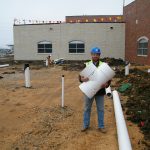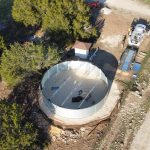Rainwater Harvesting in Dripping Springs, Texas
Dripping Springs… The Gateway to the Hill Country
Dripping Springs is located 25 minutes west of Austin and it is home to amazing natural wonders, historic treasures, shopping opportunities, live music venues, and a variety of wineries, craft breweries and local distilleries. You also can’t forget about its setting… the Texas Hill Country.
Because of these unique attributes and many others, Dripping Springs is a city that draws people to settle and live the “hill country life.” While the city may not have a large population itself, many people choose to reside in the surrounding hill country areas.
But this attractiveness has caused a population growth which stresses the local water resources. The only water supply in this area are the aquifers underfoot. Traditionally, the only water supply has been drilled water wells. With the addition of more people and homes to the area, that means more water wells and a stress on the local aquifers.

Rainwater Harvesting Systems for Potable Supply in Dripping Springs
Rainwater harvesting systems used for potable water purposes have been employed in the Hill Country for decades. Rainwater is a high quality, naturally soft, water source that needs minimal treatment.
Have an existing home in the Dripping Springs area with a water well but has the quality of the well water, issues with it’s reliability, and the required system maintenance got you wanting more from your water supply? Consider adding a potable rainwater harvesting system to diversify your water sources. We can create a hybrid system for you that will allow use of both well water and rainwater in your household. Watch out though, once you taste rainwater, you will never want to go back to your well water.
Building a new home in Dripping Springs and discouraged by the high cost of drilling a water well and the potential for unreliability over the long-term? A whole house potable rainwater harvesting system is the way to go! Why fool with water softeners, aeration tanks, or ion exchange systems that you may need to make your well water drinkable. Get off the grid with a rainwater harvesting system. By building new, we can easily design the system into your home and property in order to create a seamless water system.
Reliability? We always size your system to provide adequate water even through low rainfall periods, but remember, we can’t make it rain, so there may be times when you need water delivered to you. In the Hill Country, there are many bulk water haulers in the area. You always have the opportunity to bridge the gap between rain storms with hauled water.
What We Do
Innovative Water Solutions can take care of every detail, from design through construction, from the gutters all the way to the water line connection point to your house. We want to create the rainwater harvesting system that fits your needs and aesthetics. We would like to be your “rainwater harvesting system general contractor.”
Climate Data for Dripping Springs, TX
| Month | Avg. Rainfall (in) | Avg. ET Rate (in) | Avg. High Temp. (F) | Avg. Low Temp. (F) |
|---|---|---|---|---|
| January | 2.36 | 2.27 | 60 | 38 |
| February | 2.24 | 2.72 | 63 | 42 |
| March | 3.00 | 4.34 | 71 | 48 |
| April | 2.20 | 5.27 | 78 | 56 |
| May | 4.13 | 6.39 | 84 | 64 |
| June | 5.02 | 7.15 | 89 | 69 |
| July | 2.09 | 7.22 | 93 | 71 |
| August | 1.76 | 7.25 | 94 | 71 |
| September | 3.08 | 5.57 | 88 | 65 |
| October | 4.08 | 4.38 | 79 | 57 |
| November | 3.17 | 2.74 | 69 | 47 |
| December | 2.61 | 2.21 | 60 | 39 |
| Total | 35.74 | 57.51 |
Climate Data source: U.S. Climate Data
Evapotranspiration (ET) Rate for Austin, TX source: – Texas Agrilife Extention, TexasET Network
Frequently Asked Questions
Rainwater harvesting is the collection of precipitation from a surface to reuse at a later time. Most rainwater harvesting systems use roofs for the collection surface, but some rainwater harvesting systems do collect rainwater (or stormwater) from pervious surfaces.
For a more in-depth, detailed answer, see our “What is Rainwater Harvesting” FAQ blog post.
The simple answer is… as large of a cistern that your budget allows. In central Texas, rainfall is feast or famine, so a larger cistern helps to capture more rainwater during the “feast” times of the year so that you can use it during the “famine” times.
While the benefits of rainwater harvesting are numerous, the main benefit is that it is a sustainable water management practice that can be implemented by anyone on many different levels, from a simple rain barrel to a comprehensive rainwater harvesting system that integrates with an irrigation system or household plumbing.
Discover more benefits and advantages of rainwater harvesting in our FAQ blog.
Nothing. You can still supply your household with potable water during a drought. You just need to stay on top of monitoring your rainwater supply.
If the rainwater harvesting system was designed properly and is collecting from as much of the roof surfaces from your house, you will buffer the risk of running out of rainwater. Often, you will head into a drought with a relatively full cistern of rainwater. Even during a drought, we still get rain so there will be opportunities to replenish the rainwater volume in your cistern.
If the drought persists, then you can always call a local bulk water hauler to fill your cistern with hauled potable water so that you can bridge the gap between rain events.
Dripping Springs Project Spotlight
The Dripping Springs ISD (DSISD) opened the new Sycamore Springs Elementary / Middle School for the 2017-2018 school year. Sycamore Springs Elementary is the fourth elementary school in DSISD. It will be home to nearly 800 students in Grades PK-5 and 850 students in Grades 6-8. While the two schools will operate separately from each other, they were located on a shared 50-acre site in order to gain efficiency of resources such as a shared kitchen.
The schools employ three separate rainwater harvesting systems. Two of the systems are used to supply water for toilet and urinal flushing while the third system is used to supply irrigation water.
Each rainwater harvesting system that supplies water for toilet flushing is comprised of a 15,000 gallon corrugated metal cistern, a 500 gallon day tank, sand filter system, an UV disinfection system, and a variable speed pump system. Each system harvests rainwater from approximately 10,000 sf. Therefore, each toilet flushing system has the potential to harvest approximately 200,000 gallons of rainwater during an average year of rainfall for Dripping Springs.
The rainwater harvesting system that supplies water for the irrigation system is comprised of a 10,000 gallon corrugated metal cistern, a recirculating pump with a sand filter to filter the rainwater inside the cistern, and a variable speed pump system to pump the rainwater into the irrigation system. This system harvests rainwater from approximately 8,000 sf and has the potential to harvest approximately 160,000 gallons of rainwater during an average year of rainfall.
Want to learn more about rainwater harvesting?











